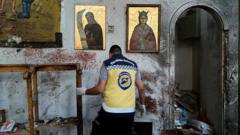As the dust settles post-Assad, the rebel group is navigating governance responsibilities with a mix of taxation and civil control, leading to mixed reactions from local residents.
New Governance in Post-Assad Syria: Insights from Rebel Administration

New Governance in Post-Assad Syria: Insights from Rebel Administration
The rise of the Islamist rebel group Hayat Tahrir al-Sham marks a new chapter for Syria as they assume control in regions previously held by the Assad regime, facing challenges and criticism.
In the aftermath of the recent overthrow of Bashar al-Assad, rebel fighters from Hayat Tahrir al-Sham are celebrating a pivotal victory that promises significant shifts in Syria's governance. This Islamist group has been at the helm of administration in Idlib Province since 2017, a region that is now a focal point for both supporters and detractors of their rule.
An illustrative example of their governance comes from the recent olive oil harvests. Each autumn, farmers in Idlib's verdant hills must contend with tax collectors who enforce a standard levy of at least 5 percent on their produce at oil presses. Farmers have expressed dissatisfaction at this tax regime, particularly in lean harvest seasons, indicating the economic strain on local agriculture.
Despite the criticisms, the Syrian Salvation Government—IDlib’s administrative body—has demonstrated a surprising degree of resilience and organizational capability. The group has implemented various taxes and has ensured that goods flowing into the territory are subject to regulation, enabling them to amass revenue. This revenue, in turn, has been funneled into military enhancements as well as essential civil services, paralleling traditional government functions that are often absent in war-torn regions.
Experts who have been monitoring the situation, along with reports from residents and international humanitarian organizations, emphasize that the group's fiscal strategies echo traits of conventional governance. This effort includes a regulatory framework for local businesses which further emphasizes their intent to maintain order and create a semblance of stability in a region long-disrupted by conflict.
With any governing body, the challenges are multifaceted. Hayat Tahrir al-Sham must balance the need for control with the realities of public discontent, confronting protests and occasional violence as they navigate the complexities of leadership amidst a fractured society. The reflections on their governance model and its implications for the future of Syria are garnering attention as the nation begins to reconstruct itself in the aftermath of six years of civil strife.
An illustrative example of their governance comes from the recent olive oil harvests. Each autumn, farmers in Idlib's verdant hills must contend with tax collectors who enforce a standard levy of at least 5 percent on their produce at oil presses. Farmers have expressed dissatisfaction at this tax regime, particularly in lean harvest seasons, indicating the economic strain on local agriculture.
Despite the criticisms, the Syrian Salvation Government—IDlib’s administrative body—has demonstrated a surprising degree of resilience and organizational capability. The group has implemented various taxes and has ensured that goods flowing into the territory are subject to regulation, enabling them to amass revenue. This revenue, in turn, has been funneled into military enhancements as well as essential civil services, paralleling traditional government functions that are often absent in war-torn regions.
Experts who have been monitoring the situation, along with reports from residents and international humanitarian organizations, emphasize that the group's fiscal strategies echo traits of conventional governance. This effort includes a regulatory framework for local businesses which further emphasizes their intent to maintain order and create a semblance of stability in a region long-disrupted by conflict.
With any governing body, the challenges are multifaceted. Hayat Tahrir al-Sham must balance the need for control with the realities of public discontent, confronting protests and occasional violence as they navigate the complexities of leadership amidst a fractured society. The reflections on their governance model and its implications for the future of Syria are garnering attention as the nation begins to reconstruct itself in the aftermath of six years of civil strife.





















